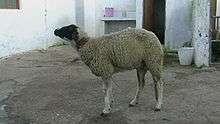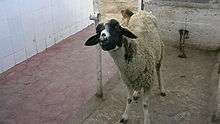Listeriosis in animals

Listeriosis is an infectious but not contagious disease caused by the bacterium Listeria monocytogenes, far more common in domestics animals (domestic mammals and poultry), especially ruminants, than in human beings. It can also occur in feral animals—among others, game animals—as well as in poultry and other birds.
The causative bacterium lives in the soil and in poorly made silage and is acquired by ingestion. It is not contagious; over the course of 30-year observation period of sheep disease in Morocco, the disease only appeared in the late 2000s (decade) when feeding bag-ensiled corn became common.[1] In Iceland, the disease is called "silage sickness".[2]
The disease is usually sporadic, but can occur as farm outbreaks in ruminants.
Three main forms are usually recognized throughout the affected species:
- encephalitis, the most common form in ruminants
- late abortion
- gastro-intestinal septicemia with liver damage, in monogastric species as well as in preruminant calves and lambs [3]
Listeriosis in animals can rarely be cured with antibiotics (tetracyclines, chloramphenicol and benzyl penicillin also) when diagnosed early, in goats, for example, by treating upon first noticing the disease's characteristic expression in the animal's face,[4] but is generally fatal.
Listeriosis in sheep

In sheep, the disease is also called the "circling disease".[5] The most obvious signs for the veterinarians are neurological, especially lateral deviation of the neck and head.
References
- ↑ Lucien Mahin, Observations on diseases of sheep in Morocco, 1977-2007, unpublished data.
- ↑ Merck Veterinary Manual, ed. 1967, p. 419.
- ↑ Roger W. Blowey & A. David Weaver, Color Atlas of Diseases and Disorders of Cattle, Elsevier, Oxford, ISBN 0-7234-3205-8.
- ↑ Pierre Gatet, veterinary practitioner at Lussac-les-Eglises, France, personal communication, 1975.
- ↑ Rue Jensen & Brinton L. Swift, Diseases of sheep, Lea & Febiger, Philadelphia ISBN 0-8121-0836-1, p. 159.